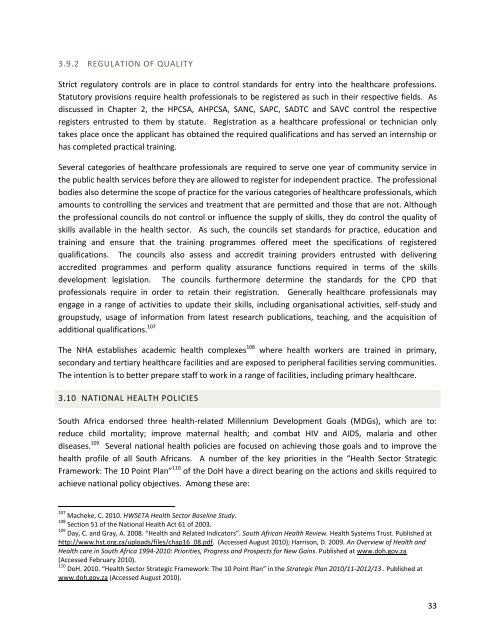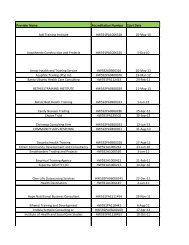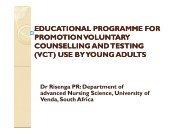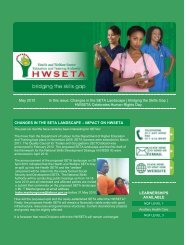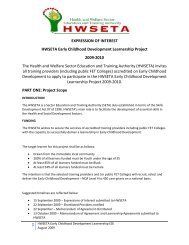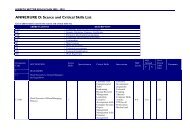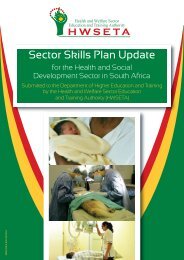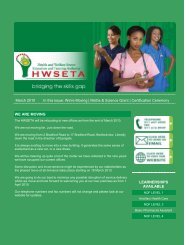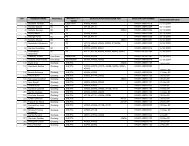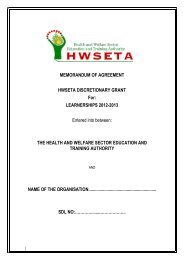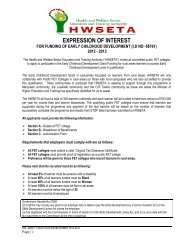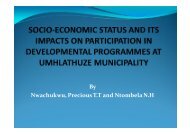sector skills plan for the health sector in south africa
sector skills plan for the health sector in south africa
sector skills plan for the health sector in south africa
You also want an ePaper? Increase the reach of your titles
YUMPU automatically turns print PDFs into web optimized ePapers that Google loves.
3.9.2 REGULATION OF QUALITY<br />
Strict regulatory controls are <strong>in</strong> place to control standards <strong>for</strong> entry <strong>in</strong>to <strong>the</strong> <strong>health</strong>care professions.<br />
Statutory provisions require <strong>health</strong> professionals to be registered as such <strong>in</strong> <strong>the</strong>ir respective fields. As<br />
discussed <strong>in</strong> Chapter 2, <strong>the</strong> HPCSA, AHPCSA, SANC, SAPC, SADTC and SAVC control <strong>the</strong> respective<br />
registers entrusted to <strong>the</strong>m by statute. Registration as a <strong>health</strong>care professional or technician only<br />
takes place once <strong>the</strong> applicant has obta<strong>in</strong>ed <strong>the</strong> required qualifications and has served an <strong>in</strong>ternship or<br />
has completed practical tra<strong>in</strong><strong>in</strong>g.<br />
Several categories of <strong>health</strong>care professionals are required to serve one year of community service <strong>in</strong><br />
<strong>the</strong> public <strong>health</strong> services be<strong>for</strong>e <strong>the</strong>y are allowed to register <strong>for</strong> <strong>in</strong>dependent practice. The professional<br />
bodies also determ<strong>in</strong>e <strong>the</strong> scope of practice <strong>for</strong> <strong>the</strong> various categories of <strong>health</strong>care professionals, which<br />
amounts to controll<strong>in</strong>g <strong>the</strong> services and treatment that are permitted and those that are not. Although<br />
<strong>the</strong> professional councils do not control or <strong>in</strong>fluence <strong>the</strong> supply of <strong>skills</strong>, <strong>the</strong>y do control <strong>the</strong> quality of<br />
<strong>skills</strong> available <strong>in</strong> <strong>the</strong> <strong>health</strong> <strong>sector</strong>. As such, <strong>the</strong> councils set standards <strong>for</strong> practice, education and<br />
tra<strong>in</strong><strong>in</strong>g and ensure that <strong>the</strong> tra<strong>in</strong><strong>in</strong>g programmes offered meet <strong>the</strong> specifications of registered<br />
qualifications. The councils also assess and accredit tra<strong>in</strong><strong>in</strong>g providers entrusted with deliver<strong>in</strong>g<br />
accredited programmes and per<strong>for</strong>m quality assurance functions required <strong>in</strong> terms of <strong>the</strong> <strong>skills</strong><br />
development legislation. The councils fur<strong>the</strong>rmore determ<strong>in</strong>e <strong>the</strong> standards <strong>for</strong> <strong>the</strong> CPD that<br />
professionals require <strong>in</strong> order to reta<strong>in</strong> <strong>the</strong>ir registration. Generally <strong>health</strong>care professionals may<br />
engage <strong>in</strong> a range of activities to update <strong>the</strong>ir <strong>skills</strong>, <strong>in</strong>clud<strong>in</strong>g organisational activities, self-study and<br />
groupstudy, usage of <strong>in</strong><strong>for</strong>mation from latest research publications, teach<strong>in</strong>g, and <strong>the</strong> acquisition of<br />
additional qualifications. 107<br />
The NHA establishes academic <strong>health</strong> complexes 108 where <strong>health</strong> workers are tra<strong>in</strong>ed <strong>in</strong> primary,<br />
secondary and tertiary <strong>health</strong>care facilities and are exposed to peripheral facilities serv<strong>in</strong>g communities.<br />
The <strong>in</strong>tention is to better prepare staff to work <strong>in</strong> a range of facilities, <strong>in</strong>clud<strong>in</strong>g primary <strong>health</strong>care.<br />
3.10 NATIONAL HEALTH POLICIES<br />
South Africa endorsed three <strong>health</strong>-related Millennium Development Goals (MDGs), which are to:<br />
reduce child mortality; improve maternal <strong>health</strong>; and combat HIV and AIDS, malaria and o<strong>the</strong>r<br />
diseases. 109 Several national <strong>health</strong> policies are focused on achiev<strong>in</strong>g those goals and to improve <strong>the</strong><br />
<strong>health</strong> profile of all South Africans. A number of <strong>the</strong> key priorities <strong>in</strong> <strong>the</strong> “Health Sector Strategic<br />
Framework: The 10 Po<strong>in</strong>t Plan” 110 of <strong>the</strong> DoH have a direct bear<strong>in</strong>g on <strong>the</strong> actions and <strong>skills</strong> required to<br />
achieve national policy objectives. Among <strong>the</strong>se are:<br />
107 Macheke, C. 2010. HWSETA Health Sector Basel<strong>in</strong>e Study.<br />
108 Section 51 of <strong>the</strong> National Health Act 61 of 2003.<br />
109 Day, C. and Gray, A. 2008. “Health and Related Indicators”. South African Health Review. Health Systems Trust. Published at<br />
http://www.hst.org.za/uploads/files/chap16_08.pdf. (Accessed August 2010); Harrison, D. 2009. An Overview of Health and<br />
Health care <strong>in</strong> South Africa 1994-2010: Priorities, Progress and Prospects <strong>for</strong> New Ga<strong>in</strong>s. Published at www.doh.gov.za<br />
(Accessed February 2010).<br />
110 DoH. 2010. “Health Sector Strategic Framework: The 10 Po<strong>in</strong>t Plan” <strong>in</strong> <strong>the</strong> Strategic Plan 2010/11-2012/13 . Published at<br />
www.doh.gov.za (Accessed August 2010).<br />
33


